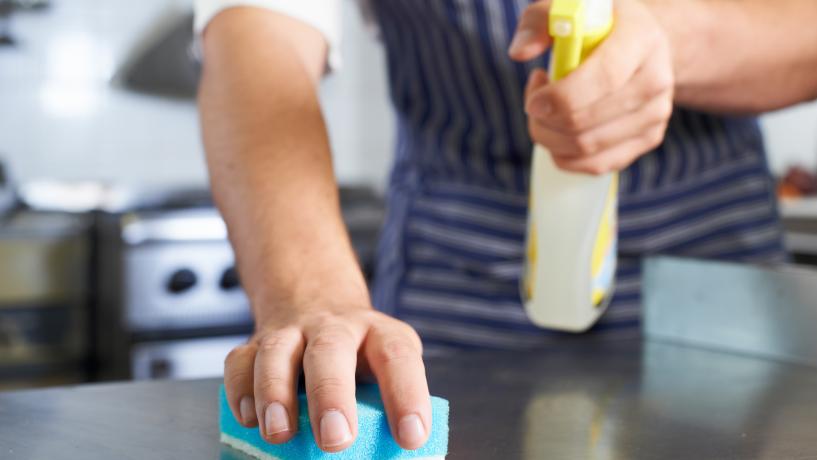
Regular cleaning and sanitising is essential to ensuring food safety anywhere where food is handled, from the hospitality industry to food transport and distribution. Especially now with the rise of the worldwide COVID-19 pandemic, maintaining a regular cleaning and sanitising schedule is vital for food businesses.
Sanitising for coronavirus (COVID-19)
SARS-CoV-2, the coronavirus that causes COVID-19, can live on surfaces for up to nine days. This means that food businesses need to be extremely diligent with maintaining the premises. The most effective way of killing the virus is through sanitising. Recent research has indicated that two commonly used sanitising methods are effective in killing coronaviruses:
- chlorine (1000ppm concentration)
- hydrogen peroxide (0.5% concentration)
Most sanitizers are effective at killing the coronavirus, but it’s important to check with your supplier to confirm that your sanitizer of choice is effective against the SARS-CoV-2 coronavirus.
To ensure the health and safety of your customers during the COVID-19 pandemic, more items than usual need to be sanitized. Anything that is touched often or located in a high traffic area needs to be sanitized including credit card machines, tables, menus, salt and pepper shakers.
Many virus and food-borne illness outbreaks occur as a result of poor cleaning and sanitising procedures. To ensure food safety, cleaning must always be followed by sanitising.
When deciding on the best method for cleaning and sanitising a particular item, you’ll need to consider:
- the item to be cleaned
- the type of soiling
- your water supply
- water temperature
- cleaning and sanitising agents
The three most common cleaning and sanitising methods used in commercial kitchens are:
- Manual
- Mechanical
- Clean-in-place
Manual cleaning and sanitising
Manual cleaning and sanitising is used for surfaces, equipment and utensils.
Before beginning, be sure to clean and sanitise the sink and surfaces you’ll be using. Your station should be equipped with everything you need to perform the required cleaning and sanitising tasks, including:
- garbage containers for waste
- cleaning and sanitising agents
- draining racks
Manual cleaning and sanitising is a six or seven step process, depending on the sanitising method you use. It involves:
- removing dirt, grease and food scraps
- cleaning with an appropriate cleaning agent (e.g. detergent, degreaser)
- sanitising using a chemical sanitiser or hot water
If using the hot water sanitising method, ensure the item is fully immersed in hot water for the appropriate length of time, and be careful not to burn or scald your hands while performing these tasks.
Always use the right cleaner or sanitiser for the job you’re doing.
Mechanical cleaning and sanitising
Mechanical cleaning and sanitising involves using a dishwasher or other automated cleaning equipment. Mechanical dishwashers are most frequently used for dishware, utensils, glassware and small items of kitchen equipment.
Most food businesses use a combination of manual and mechanical cleaning and sanitising. Some machines use a high-temperature rinse to sanitise, while others use a chemical sanitiser.
If using a mechanical dishwasher to clean and sanitise items, the steps are similar to manual cleaning and sanitising. You’ll want to scrape and rinse off as much food residue as you can before loading the machine.
Avoid overloading the machine, as this can prevent items from getting properly cleaned and puts unnecessary wear and tear on the machine.
Depending on the sanitising method used by your machine, you’ll want to perform the following checks daily:
- maximum water temperature
- chemical concentration
Always follow the manufacturer’s instructions for your mechanical dishwasher and keep it in good repair. Failure to do so could cost you points on your next health inspection.
Clean-in-place cleaning and sanitising
Some kitchen equipment is designed to be ‘cleaned in place’. Clean-in-place cleaning and sanitising is generally done if an item is too large or too cumbersome to be moved.
For example:
- soft serve ice cream machines
- coke dispensers
- espresso machines
These types of machines are usually designed with pipes or other apparatus that allow the equipment to be properly cleaned. Hot water, detergent and sanitiser are flushed through the machine to remove dirt and soiling, and eliminate microorganisms.
Always follow the manufacturer’s instructions to avoid damaging the machines or contaminating food/beverages with harsh chemicals that could make a person sick.
Work surfaces are also considered clean-in-place equipment, as they are generally fixed in place.
Why is cleaning and sanitising important?
Cleaning and sanitising in a food business or community organisation — particularly those that provide food to vulnerable persons — is crucial.
Food Handlers must receive food safety training to ensure they know how, what and when to clean and sanitise, as well as the risks of not following food safety procedures.
Food safety training also makes good business sense, because effective cleaning and sanitising:
- prevents pest infestations;
- helps ensure your business passes health inspections;
- helps to protect customers from viral outbreaks like COVID-19
- helps to protect customers from food poisoning, injuries and allergic reactions to food.
Improperly handled food can cause illness or even death. Consistent, effective cleaning and sanitising will help to prevent this from happening in your facility.
Effective cleaning and sanitising, cleaning and sanitising methods and sanitation plans are covered in depth in the AIFS Food Safety Manager course.
To learn more about the Food Safety Manager course, contact the Australian Institute of Food Safety.





